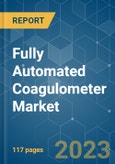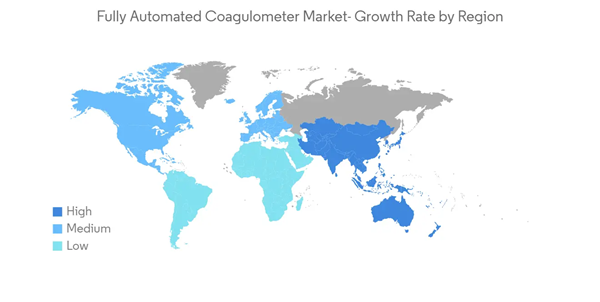Key Highlights
- The outbreak of the pandemic impacted the fully automated coagulometer market. Blood-related diseases increased during the pandemic as many people were seen to acquire hematologic disorders along with COVID-19. For instance, as per the NCBI study published in November 2021, some people with COVID-19 develop abnormal blood clots, including in the smallest blood vessels. Clots can also form in multiple places in the body, including the lungs. This abnormal clotting can cause a variety of complications, including organ damage, heart attack, and stroke.
- Thus, increasing cases of blood-related diseases in the initial days of the pandemic accelerated the demand for fully automated coagulometers, as it is one of the essential requirements for the diagnosis of blood-related diseases. Therefore, the market is anticipated to witness considerable growth in the current year and is expected to continue the upward trend over the forecast period.
- The growing burden of blood-related diseases is one of the major drivers for the market. For instance, as per the report published by the Leukemia & Lymphoma Society (LLS) in 2021, approximately every three minutes, one person in the United States is diagnosed with leukemia, lymphoma, or myeloma every year and an estimated combined total of 186,400 people in the United States were diagnosed with leukemia, lymphoma or myeloma in 2021. The report also stated an estimated 34,920 new cases of myeloma (19,320 males and 15,600 females) were diagnosed in the United States in 2021.
- Furthermore, per the NIH study published in April 2022, leukemia was estimated to be the 15th and 11th most frequent cause of cancer incidence and cancer-related mortality globally, accounting for 474,519 incident cases and 311,594 deaths in 2020. Therefore, such instances are anticipated to propel the demand for automated coagulometers as it is one of the key requirements for managing blood-related diseases.
- The launch of new innovative products is also anticipated to propel market growth. For instance, in October 2021, Trivitron Healthcare launched a new range of coagulation analyzer products manufactured by Diagon Ltd. Trivitron, in collaboration with Diagon-Vanguard Diagnostics India, announced the launch of these products in the Indian diagnostic market following the signing of a collaboration agreement between the companies.
- New products include automated, semi-automated, and POC systems of the COAG series manufactured by Diagon Hungary to reduce the risk of bleeding in major surgeries and monitor the effectiveness of hemostatic therapies and anticoagulant drugs. Therefore, such innovations may create new opportunities for the market, which may encourage many new players to enter the market. Thus, considerable market growth is expected over the forecast period.
- However, the high cost of the test is likely to restrain the market growth over the forecast period.
Fully Automated Coagulometer Market Trends
Hospital Segment Expected to Witness Considerable Growth Over the Forecast Period
- Hospitals are well-equipped with advanced technological equipment for diagnostic and surgical procedures and improved treatments. The hospital segment is witnessing rapid growth, owing to the growing number of diagnostic and surgeries due to blood-related diseases. This trend is expected to continue over the forecast period, driving growth in the segment.
- With the rising number of hospitals across developing countries, there is a positive impact on the demand for fully automated coagulometers. For instance, according to the American Hospital Association annual survey 2021, in the United States, there were more than 1,805 rural community hospitals, 3,336 urban community hospitals, and 3,453 community hospitals in the system in 2020. Moreover, total admissions in all United States hospitals were more than 36,241,815 in 2021.
- Similarly, as per the April 2021 report of the Center for Disease Dynamics, Economics and Policy (CCDEP), there were 25,778 public sector hospitals in the country, and the states with the highest number of public hospitals were Uttar Pradesh (4,635), Karnataka (2,842), Rajasthan (2,850), Odisha (1,806), and West Bengal. Hospitals are the major treatment centers for blood-related diseases globally, owing to the low cost of surgeries and medication and the availability of state-of-art infrastructure. Hospitals offer integrated services from diagnostics to treatment and treatment to post-treatment, which is patients' first choice for any diagnostic and treatment procedure. Thus increasing the number of hospitals may increase the number of patients, which is expected to positively impact the segment.
- Therefore, owing to the abovementioned factors, the segment is anticipated to witness considerable growth over the forecast period.
North America Expected to Witness Significant Growth Over the Forecast Period
- North America is expected to dominate the overall fully automated coagulometer market over the forecast period. The growth is due to factors such as the rising cases of blood-related diseases and the launch of new product lines by the key players in the region. For instance, as per the report published by the Leukemia & Lymphoma Society (LLS) in 2021, new cases of leukemia, lymphoma, and myeloma accounted for around 9.8% of the estimated 1,898,160 new cancer cases in the United States in 2021.
- Similarly, as per the report published by the Canadian Cancer Society in May 2022, around 6,700 Canadians will be diagnosed with leukemia, 4,000 men will be diagnosed with leukemia, and 1,800 will die from it in 2022. Therefore, such instances indicate that the demand for fully automated coagulometers may increase, thereby propelling the market growth in the North American region.
- Key product launches, high concentration of market players or manufacturer's presence, acquisition and & partnerships among major players, and rising cases of blood-related diseases in the United States are some of the factors driving the growth of the fully automated coagulometer market in the country. For instance, as per the report published by the Leukemia & Lymphoma Society (LLS) in 2021, an estimated 1,519,907 people in the United States (US) were living with or in remission from leukemia, lymphoma, myeloma, myelodysplastic syndromes (MDS) or myeloproliferative neoplasms (MPNs) in 2021. The report also stated that around 90,390 people in the United States were diagnosed with lymphoma in 2021 (8,830 cases of Hodgkin Lymphoma and 81,560 cases of Non-Hodgkin Lymphoma).
- Therefore, owing to the aforesaid factors, the growth of the studied market is anticipated in the North America Region.
Fully Automated Coagulometer Market Competitor Analysis
The fully automated coagulometer market is consolidated and consists of a few major players. Product launches and strategic alliances by companies are expected to drive the fully automated coagulometer market growth. The competitive landscape includes an analysis of a few international as well as local companies which hold market shares and are well known, including HemoSonics LLC, Siemens Healthcare, Abbott Laboratories, F. Hoffmann-La Roche Ltd, Erba Group, Werfen, Horiba, Haemonetics Corporation, and Maccura Biotechnology Co. Ltd, among others.Additional benefits of purchasing the report:
- The market estimate (ME) sheet in Excel format
- 3 months of analyst support
This product will be delivered within 2 business days.
Table of Contents
Companies Mentioned (Partial List)
A selection of companies mentioned in this report includes, but is not limited to:
- Maccura Biotechnology Co. Ltd
- Siemens Healthcare
- Werfen
- Horiba
- Haemonetics Corporation
- HemoSonics LLC
- F. Hoffmann-La Roche Ltd
- Erba Group
- Diagon
- iLine Microsystems SL










